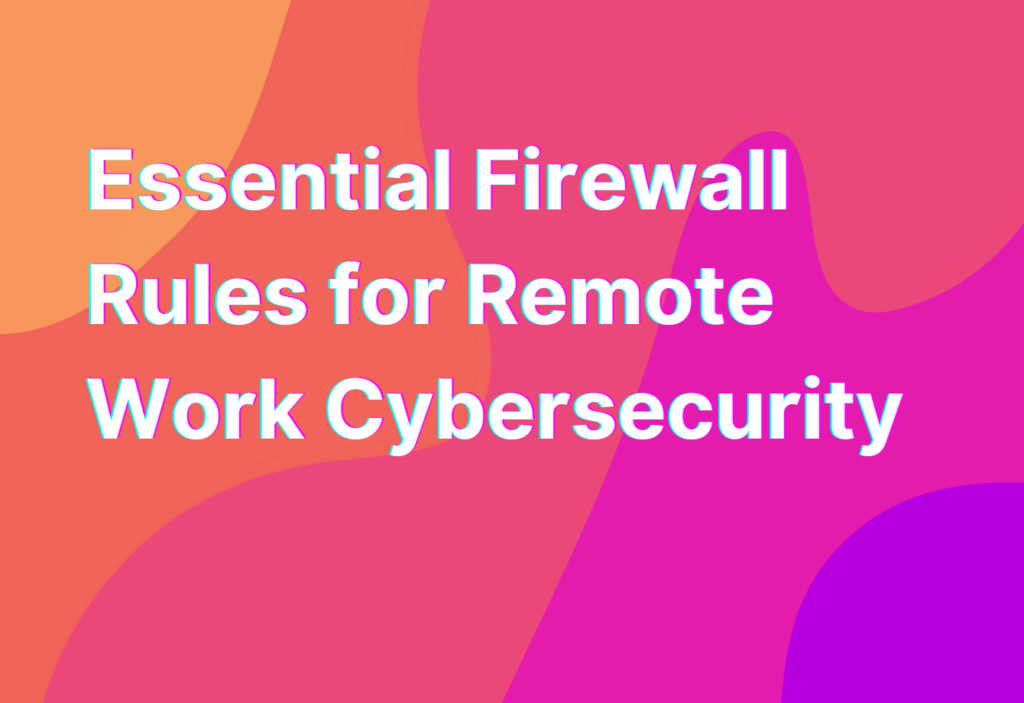Essential Firewall Rules for Remote Work Cybersecurity
Hey there, remote workers! It’s Ashley, your friendly remote work advocate, here to talk about an important aspect of cybersecurity: firewall rules. As we navigate the world of remote work, it’s crucial to prioritize the security of our digital assets. One way to do that is by setting up and maintaining effective firewall rules. In this article, I’ll walk you through some essential firewall rules that every remote worker should know. So, grab your favorite cup of coffee and let’s dive in!
1. Allow Only Necessary Traffic
When it comes to firewall rules, less is often more. It’s important to only allow the necessary traffic to pass through your network. By default, firewalls block all incoming connections, but you’ll need to configure them to allow specific types of traffic. This helps to minimize the potential attack surface and reduces the risk of unauthorized access.
For example, if you primarily use your remote work setup for web browsing, you’ll want to allow traffic on port 80 for HTTP and port 443 for HTTPS. However, if you don’t need to access certain services, such as file sharing or remote desktop, it’s best to block those ports to prevent any potential vulnerabilities.
2. Implement Intrusion Detection and Prevention Systems
Firewalls are great, but they can’t catch everything. That’s where intrusion detection and prevention systems (IDPS) come in. These systems monitor network traffic for any suspicious activity and can automatically block or alert you about potential threats.
By implementing an IDPS, you add an extra layer of security to your remote work setup. It can help detect and prevent attacks like port scanning, brute force attempts, and even malware infections. So, make sure to include an IDPS as part of your cybersecurity arsenal.
3. Regularly Update Your Firewall
Just like any other software, firewalls require regular updates to stay effective. Cybercriminals are constantly finding new ways to exploit vulnerabilities, and firewall vendors release updates to patch those vulnerabilities. It’s crucial to stay on top of these updates to ensure your firewall is providing the best possible protection.
Set up automatic updates for your firewall software, if available, or make it a habit to check for updates regularly. This simple step can go a long way in keeping your remote work environment secure.
4. Enable Logging and Monitoring
Logging and monitoring are essential for maintaining the security of your remote work setup. By enabling logging on your firewall, you can keep track of any suspicious activity or attempted breaches. This information can be invaluable in identifying potential security threats and taking appropriate action.
Additionally, consider implementing a centralized log management system that aggregates logs from multiple sources. This can help you easily analyze and correlate data, making it easier to detect any patterns or anomalies that may indicate a security breach.
5. Educate Yourself and Your Team
While firewalls are an important line of defense, they’re not foolproof. It’s crucial to educate yourself and your remote work team about cybersecurity best practices. This includes topics like phishing awareness, password hygiene, and safe browsing habits.
Investing in regular cybersecurity training can go a long way in preventing security incidents. Remember, the weakest link in your cybersecurity chain is often the human element. By empowering yourself and your team with knowledge, you can significantly reduce the risk of falling victim to cyber threats.
Wrapping Up
And there you have it, remote workers! Some essential firewall rules to keep your remote work setup secure. By allowing only necessary traffic, implementing intrusion detection and prevention systems, regularly updating your firewall, enabling logging and monitoring, and educating yourself and your team, you’ll be well on your way to a more secure remote work environment.
Remember, cybersecurity is an ongoing process, so make sure to stay informed about the latest trends and best practices. If you want to dive deeper into the essentials of HTTPS cybersecurity for remote work, check out this link for more information.
Stay safe and secure out there, remote teamers!


